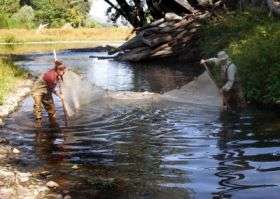Tiny fish can yield big clues to Delaware River health

Where have all the bridle shiner gone? That’s the mystery The Academy of Natural Sciences’ fish scientists are trying to answer, and the outcome will shed light on the environmental health of the Upper Delaware River.
Bridle shiner—not easy to spot at less than two inches long—once were abundant in the mid-Atlantic region, including small streams in Southeastern Pennsylvania. Their steady decline has prompted Pennsylvania to classify the fish as endangered. Now, the Academy is swimming the tide to lay the groundwork for an environmental management plan for the species and its habitat.
The Academy’s Patrick Center for Environmental Research, in partnership with the Upper Delaware Scenic and Recreational River and the Delaware Water Gap National Recreation Area, is in the midst of a two-year project to discover and describe the status of the little minnow in the Upper Delaware River basin. Academy fisheries scientists David Keller and Shane Moser, under the direction of Dr. Richard Horwitz, have cast their seine nets and gone snorkeling many times at various locations over the last year with varying results. Their findings will shed light on the health of the Upper Delaware River and will factor into decisions made about the flow of the river.
“The presence and absence of fish helps us define preferred habitat for the fish, which helps us locate potential sites for sampling,” explained Horwitz. “We've located several sites with populations of the species, and in other places we've found a few fish on one visit, but not on subsequent visits. These sites may lead us to sites with large populations.”
Academy studies reveal possible causes of the species’ decline may include changes in water quality due to siltation, nutrient enrichment and changes in flow patterns, and the introduction of predators, such as largemouth bass, as well as competitors for food. Interestingly, a decline in the beaver population also may factor into the decline.
“We’ve found bridle shiner in ponds formed by beaver activity,” said Horwitz. “Beaver were once extirpated or nearly extirpated in the region. Beaver have become re-established and numbers have been increasing, which may provide new habitats for the bridle shiner.”
The results of the Academy’s studies, which will continue into 2008, will factor into the Delaware River Basin Commission’s flow management plans for the river. Bridle shiner prefer slow-moving, shallow waters that flow over beds of aquatic plants. The Upper Delaware River region provides drinking water, supports a number of native fish species, and is popular for sport fishing and other recreational activities. Flow management can affect all these resources; in addition, flooding is a concern in some riverside communities.
“Our goal is to develop management plans to protect the fish and its habitat,” said Horwitz. “Water flow and temperature in the Upper Delaware River’s backwater habitats are key to doing this.”
The historical status of bridle shiner in Pennsylvania is known mostly from early 20thcentury collections held at the Academy. The species was originally described by naturalist Edward Drinker Cope, who discovered the fish in a tributary of the Schuylkill River in Conshohocken, Pa., where it no longer occurs. Cope’s personal collection of fishes, reptiles and amphibians was bequeathed to the Academy in 1898.
Source: The Academy of Natural Sciences


















